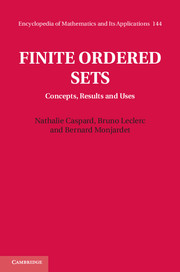Book contents
- Frontmatter
- Contents
- Preface
- 1 Concepts and examples
- 2 Particular classes of ordered sets
- 3 Morphisms of ordered sets
- 4 Chains and antichains
- 5 Ordered sets and distributive lattices
- 6 Order codings and dimensions
- 7 Some uses
- A About algorithmic complexity
- B The 58 types of connected ordered sets of size at most 5
- C The numbers of ordered sets and of types of ordered sets
- D Documentation marks
- References
- List of symbols
- Index
5 - Ordered sets and distributive lattices
Published online by Cambridge University Press: 05 February 2012
- Frontmatter
- Contents
- Preface
- 1 Concepts and examples
- 2 Particular classes of ordered sets
- 3 Morphisms of ordered sets
- 4 Chains and antichains
- 5 Ordered sets and distributive lattices
- 6 Order codings and dimensions
- 7 Some uses
- A About algorithmic complexity
- B The 58 types of connected ordered sets of size at most 5
- C The numbers of ordered sets and of types of ordered sets
- D Documentation marks
- References
- List of symbols
- Index
Summary
The particular ordered sets called lattices have been defined in Chapter 1. In Chapter 2, we introduced some particular classes of lattices such as distributive, modular, or semimodular lattices. The class of distributive lattices is the most significant for several reasons. First, the distributivity properties between the two operations make the algebraic handling of such lattices easier. Then, many natural orders in pure or applied mathematics are distributive lattices, to begin with chains and lattices of subsets of a set. The latter are isomorphic to direct products of 2-element chains; more generally, any product of chains is a distributive lattice. Then, when in a multicriteria decision problem the possible options are assessed according to several linearly ordered criteria, these options are elements of the distributive lattice, which is the product of these orders. Finally and above all, there exists a fundamental correspondence between ordered sets and distributive lattices allowing any property or question on ordered sets to be translated into a property or question on distributive lattices (and conversely). For instance, in scheduling problems where one must search for a linear extension of an ordered set, considering the corresponding problem on an associated distributive lattice turns out to be profitable (see Section 7.5).
In Section 5.1 we give several characterizations of distributive lattices (Theorem 5.1) and examples of such lattices. In the following section, Theorem 5.6 describes the properties of a distributive lattice associated with an ordered set, namely the lattice of its downsets (ordered by inclusion).
Information
- Type
- Chapter
- Information
- Finite Ordered SetsConcepts, Results and Uses, pp. 130 - 162Publisher: Cambridge University PressPrint publication year: 2012
